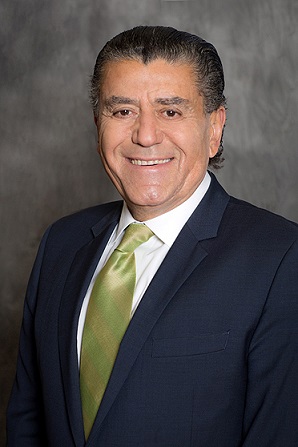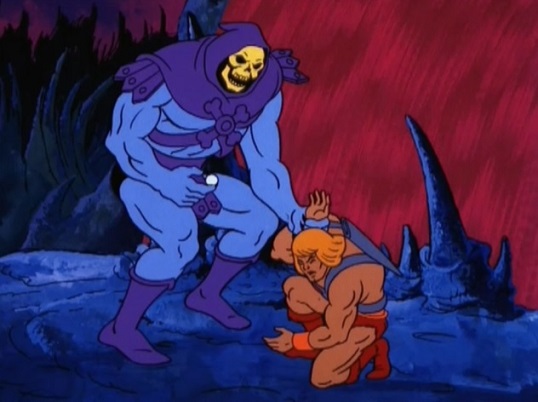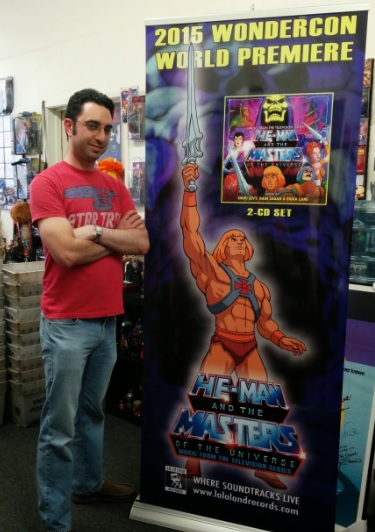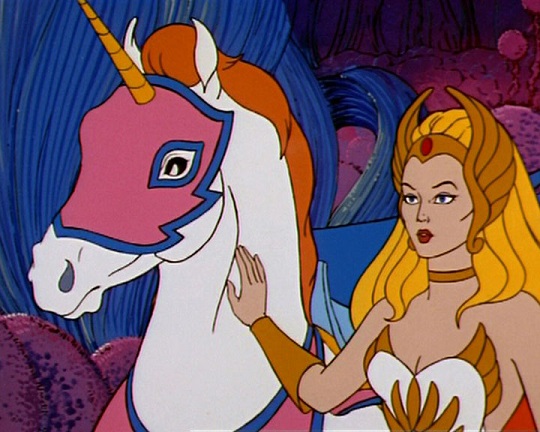10 Revelations From the New He-Man Soundtrack Album’s Producers
 |
| La-La-Land Records |
Like many who spent time on Eternia in the ’80s, what I remember most about the original He-Man and the Masters of the Universe cartoon is its insanely catchy theme song. That deceptively simple title track not only stirred our emotions with its sweeping melody, but managed to repeat the main character’s name 10 times in under a minute and a half. No wonder it’s so iconic! And yet as memorable as it was, the rest of the show’s music has largely been forgotten… until now. Making its long awaited debut, La-La-Land Records presents a deluxe 2-CD set of the He-Man and the Masters of the Universe soundtrack, featuring over 90 minutes of previously unreleased music. I talked with John Takis and Neil S. Bulk, the album’s Producers, about the series’ signature sound and what it took to bring this meticulously restored television score to life.
John Takis is a freelance writer and longtime film music enthusiast who has provided liner notes and historical analysis for more than 75 film and television soundtrack releases. He spoke with me about producing the He-Man soundtrack and discussed the role of music in the classic animated series.
1. “That’s Pretty Cool!”
 |
| John Takis |
Topless Robot: Being a fan of the franchise, as you and I both are, what was your first thought when La-La-Land Records approached you about co-producing the He-Man soundtrack?
John Takis: To give you some context, La-La-Land had already been working on this set for years. And most of that was spent trying to find the original materials. Neil Bulk can speak more specifically to that aspect. They were planning this even before that big DVD boxed set came out a few years ago. And I was asked at that point if I wanted to provide the notes. My first thought was, “That’s pretty cool!” It’s always nice to be able to go back and work on a project that you have some sort of personal connection to. As a child of the ’80s, this took me straight back to that time.
TR: Did you watch the series when it originally aired?
JT: I have to clarify. I was not a heavy watcher of the series during its initial syndicated run. I must’ve been about three or four years old when it started. But the multi-media nature of He-Man made it unavoidable. Unless you were raised on an Amish farm somewhere. :laughs: Some of the earliest toys I remember playing with were He-Man toys. Even in kindergarten! I was fascinated by Moss Man and Stinkor, the one that had the real skunk smell! :laughs: When you’re five years old that’s pretty cool. I remember the vehicles, and I had a little Orko figure that spun around. And so, while it wasn’t a show I was obsessed with growing up, it was definitely in the mix. As for the music, Haim Saban and Shuki Levy were responsible for scoring so many cartoons in the ’80s that even if you weren’t a fan of He-Man specifically, if you watched cartoons at that time, their sound is in your blood.
2. Revisiting the Series
 |
| Matthew Chernov |
TR: Can you describe some of your responsibilities as a record Producer?
JT: There are a couple of levels of production. It starts with the Executive Producers. They’re the ones who secure the rights, set the budget, and make sure that everything can move forward. Then they’ll pass the project on to an album Producer. On a project like this, where I work with Neil, he usually handles the technical side, coordinates the mixing and the mastering. I mean, it varies from project to project. On this particular album, I did a lot of research and hunted down information for the liner notes. We needed to be aware of what was out there already, and had discussions about the best way to present the material. That’s how we decided to include the original stereo LP along with the mono tapes we found. Sometimes there were multiple versions of tracks, and we had to go back to see what was used in the series. And so there was a lot of research needed for that. Neil actually came up with the final track order, which I think makes for a great listening experience. I was also kind of the go-to guy to interface with Dan Goldwasser, who was our Associate Producer and Art Director.
TR: Speaking of which, the artwork on this set is really beautiful. The booklet, the cover and the disks look great.
JT: They really do! Of the three of us, I was kind of the one who was most familiar with the show. And when I found out I was working on it a couple of years ago, I ran out and re-watched the entire series all the way through, which is something I’d never done, because like I said, as a child I was only a casual viewer. So it wasn’t until these last few years that I had the luxury to sit down with the new DVDs and revisit the series as an adult.
TR: And what was that like?
JT: I had a blast! An absolute blast. I think what surprised me most was how innocent the show seems now. At the time, of course, it was very controversial. And now you watch it and it seems like the most harmless thing in the world. They deliver a nice little moral lesson at the end of each episode and always preach non-violence. It’s refreshingly innocent. Certainly it’s cornball – I don’t think anyone can deny that – but enjoyably so. And because I’d gone back and revisited the series, I kind of became the question and answer guy, and helped explain which artwork came from which version of the show.
3. The Spanish He-Man
 |
| Portal Disk |
TR: When I think of He-Man and music, the theme song instantly springs to mind. What is it about that track that makes it so memorable?
JT: Quite simply, it’s the fact that you can sing his name to the tune! When a co-worker heard that I had worked on this soundtrack, he said he didn’t remember any of the music except for “HE-MAN!” Everyone knows that part! :laughs: And certainly it was repeated ad nauseum on the show. But as John Williams demonstrated with the soundtrack to Jaws, sometimes the most memorable ideas are the simplest. There’s an undeniable appeal in having the character’s name in there. You remember it!
TR: One of the most interesting tracks on the new album is the Spanish version of the theme song. What’s the story behind that?
JT: Well, I can only say so much about that in terms of its origins. But every non-English-speaking region had to decide how to handle the opening theme. Chilean vocalist Memo Aguirre had some history working in animation, and I can tell you that in at least some Spanish-speaking regions, the theme song did air with his vocal in the background. And if you listen to the lyrics, it more or less corresponds to Prince Adam’s narration from the opening. He’s basically telling the story of who this guy is.
4. The Saban Empire
 |
| Saban Capital Group Inc. |
TR: I was surprised that Ray Ellis didn’t score the series, because he was one of Filmation’s most prolific composers. Was that a stylistic choice?
JT: The only real clue that my research turned up was in Lou Scheimer’s autobiography. Scheimer was one of the founders of Filmation. He put it down to Ellis being reluctant to sign on to such a risky project. You have to remember, this was a big risk. And actually, Filmation was struggling at the time. They needed a hit. And they didn’t really last long after He-Man and She-Ra. So it may have been that Ellis saw the writing on the wall. From what I read, I don’t believe it was a stylistic decision.
TR: His absence ultimately led to Haim Saban entering the picture. What can you tell me about him?
JT: Saban is a fascinating and, some might say, polarizing figure. I mean, you don’t get to be a multi-billionaire without making a few enemies. :laughs: He didn’t take the lead on actually writing the music. He was a musician, but he was always more of the brains behind the scenes. He was the manager who guided the company and helped make it successful. That’s why he went into animation. He started looking at royalties and saw an opportunity, because in animation the music was pretty much non-stop. He was the business guy who beat down doors and persuaded executives to hire them. And he was incredibly successful at it! He was working with Filmation and their competitors.
TR: Did he bring Shuki Levy on to score He-Man?
JT: Yes, he was Levy’s manager in Europe. And when he came over to form the American leg of what was becoming the Saban empire, Levy and some others came with him. Levy was the lead musician. If Saban was the business mind, Levy was the music mind. And he kind of took point on the actual composing.
5. The Love Theme of Teela and Orko
 |
TR: While listening to the soundtrack, Teela’s theme really stood out for me. It’s sweet, without being too cloying. Is that how you’d describe it?
JT: One of the things that Saban and Levy were very good at was writing themes that matched the characters. That’s a valuable skill in many ways. To create a melody that reflects character is important. And I think you’re right. There’s a sweetness to Teela, without being overly saccharine. She’s the Captain of the Guard, a fighter, and the show generally shied away from romantic tension. I mean, there’s a little bit of it in there, but that wasn’t what the series was about. So Teela was a strong character, but had a lot of compassion too. And her theme has a nice octave leap in there that reflects that.
TR: Orko’s theme is very distinctive as well. There’s a magical, humorous quality to it.
JT: Again, Orko’s theme is a close match to his character. It’s very active. He’s a funny character, always trying to help. Frequently, he’s the reason that the plot happens. So he gets a very active theme, with a mystical element to it.
TR: Instrumentally, when we listen to the He-Man soundtrack, what are we actually hearing? Is it one person at a keyboard, or multiple musicians, or something in between?
JT: Something in between, and it depends on the track as well. A lot of it is synth based, and certainly there’s some sampling going on. But some of it was live performance. Some keyboards and guitar. Levy was a pop musician, and Saban offered him a chance to compose. They both had origins in pop and rock, and brought a kind of progressive musical sensibility to the score. What they came up with was very unique. You mentioned Ray Ellis earlier. Well, if you compare those Ellis shows with He-Man, the Ellis shows were informed more by jazz and traditional orchestral music. If you look at shows like G.I. Joe or Transformers, those were an outgrowth of what Ellis was doing, in that they were symphonically oriented. Whereas He-Man was very much pop oriented. He-Man was something new. The sound that Saban and Levy created helped shape the genre. And that’s why it was so exciting to work on this album!
6. Energy and Texture
 |
TR: Are there any particular tracks that you think fans should listen for, other than the big themes?
JT: There’s a track that a lot of people have been looking forward to that was used in a scene where He-Man goes head-to-head against Skeletor. That’s a cue called “Bad Attack.” I think fans will really like that one.
TR: What other cartoons from this period would you like to take a crack at producing in the future?
JT: For me, personally, probably the one that I loved most from that period was Inspector Gadget, which was also scored by Saban and Levy. That would probably be the one for me. That and She-Ra, of course. I’m sure we’re going to be inundated with requests now for She-Ra! :laughs: The challenge is finding the material! But for now, He-Man is certainly one of the pillars of this era of animation, and it’s very satisfying that people will finally get to hear so much of it on CD for the first time.
TR: Overall, if you had to sum up the role of music in the He-Man series, what would you say?
JT: Two very important things. The first is energy. The animation really benefited from having such a high-energy score. When that music pops up and He-Man goes into action, it really ramps up the level of excitement. The music is a real partner with the characters. It’s not just their vocal performances, which are excellent. The music is a partner in making those characters come to life. And the second thing is texture. The show has a really interesting texture. The music is heroic enough, but it can also get very weird. There’s a track on the CD called “Tar Swamp” that’s a good example. Overall, the music helped make the world of Eternia seem unique and alive. You have the character stuff and the textural element, and they both combine into something very memorable, which is why we’re talking about it today!
Neil S. Bulk is a freelance soundtrack Producer and Editor who’s worked on numerous reissues and boxed sets for labels like La-La-Land Records, Varese Sarabande, and Intrada. In 2013 he won the International Film Music Critics Association award for Best Archival Release of an Existing Score (Compilation) for the 8-CD Lethal Weapon Soundtrack Collection on La-La-Land Records. He spoke with me about the challenges and responsibilities of producing the deluxe He-Man soundtrack.
7. From Fisher-Price to Battle Armor He-Man
 |
| Neil S. Bulk |
Topless Robot: Can you tell me a little bit about yourself? For instance, what’s your musical background?
Neil S. Bulk: I’m actually not a musician, which sometimes surprises people. I grew up as a fan. My dad raised me on classical music and would buy me records and movie soundtracks. In fact, the first soundtrack I owned was Star Trek: The Motion Picture. I listened to it on my Fisher-Price record player when I was three. :laughs:
TR: How did you go from listening to records to producing them?
NB: Well, I was living in New Jersey and met some people who worked in L.A., and I thought okay, I’ll take my shot! So I moved out here and went to school. At the time, I thought I would be editing sound for movies. But that plan didn’t really work out, so instead, I wound up getting involved in film scores. My friends were doing it and would ask me for help sometimes. You know, “Can you cut this for me? Can you fix that?” So I started doing favors for people, and then it turned into larger projects, and I just kept meeting more people in the business.
TR: So a lot of networking, basically.
NB: Exactly. That’s what it came down to. I learned how to cut in Pro Tools at Video Symphony, which is a creative, technical school. They had a Pro Tools program, so I went through it and learned the trade. And that’s what I do all day. I sit at the computer, cutting and listening. I’m fortunate to work in a career where I happen to love this music.
TR: Were you a fan of the He-Man series in the early 80s?
NB: I was in second grade when it premiered. I remember we were all excited and ran home after school to watch it. But I never really had the toys so much. I mean, I had a few. I had Battle Armor He-Man, which had this armor on a wheel that would rotate. You’d turn it and a dent would appear. And then another dent! :laughs: I preferred Star Wars toys. I had GoBots, Transformers… and that was about the limit of my toy collecting. I watched the He-Man series since it was on after school, along with Super Friends and maybe Popeye. But I grew out of it pretty fast.
8. The Tale of the Tape
 |
| Matthew Chernov |
TR: How did you get involved with producing this deluxe He-Man soundtrack?
NB: La-La-Land Records had been working on He-Man for a long time. And ultimately, they sent me an email of a manifest from wherever the surviving tapes were located and asked me what they should get for the soundtrack. They basically wanted to know which of these He-Man tapes they needed. But the manifest was vague, so we just pulled in everything.
TR: You pulled it in from where?
NB: The tapes were in England. I don’t know how they got there, or why, or who owned them. So we had them transferred by Johnny Dee Davis at Precision AudioSonics. And it was interesting to sit down and finally listen to them, because I had the scans of the boxes and the paperwork, and there were titles for everything, but I didn’t know exactly what it was or what the quality would be like. So I listened to the tapes and thankfully it was the music we wanted from the 1983 animated series.
TR: When you say tapes, what kind are you talking about?
NB: The tapes were quarter-inch. Those are big reel-to-reel tapes, you know? And it was all mono. But there had been previous CDs of He-Man that were stereo, and I wanted to figure out where that stereo material came from. I had a lot of the same music, but I only had it in mono. So we found out that there was a stereo LP release in the past, and we got it, and had it transferred, and it just sounded terrific. None of the other albums sounded as good as this. But since we couldn’t find a stereo master, the closest thing we had was this vinyl. So we had it cleaned up by our Mastering Engineers, Stephen Marsh and Fernando Lee, and now we have the original stereo album included on our CD, along with all of this first generation mono stuff from the quarter-inch tapes. It’s a revelation in terms of quality!
TR: Listening to the He-Man score in preparation for this interview, I was struck by its resemblance to Broadway shows like Starlight Express. Am I off-base on that assessment?
NB: I haven’t heard Starlight Express so I can’t tell you. :laughs: As far as the music goes, it is what it is! It was perfect for the cartoon, and it was very different from what Filmation was using on their other shows. Filmation tended to be a bit more theatrical and orchestral, and this was definitely a departure for them.
9. “Where’s She-Ra?”
 |
TR: Can you describe some of your typical responsibilities as a record Producer?
NB: What I tend to do is sit down with the music and the movie, or the TV show, and in Pro Tools I can take a bit of music and put it right underneath the movie, and I can look at it and listen to it. I can go “yes, this is the same performance” and move on, or I can go “this doesn’t sound very good, there’s a pitch problem.” So basically what I do is listen to it, make sure it’s the right performance, make sure it sounds good, and make notes about any audio problems that we need to fix. Then, if it’s a stereo album, I pass it on to a Mixing Engineer. When I get it back, I listen to it again, and if I’m satisfied I pass it on to a Mastering Engineer who puts all of the mixes on to an album in the sequence that we’ve mapped out. They’ll balance things, make it sound even, make it sound consistent, then it comes back to me and I listen to it over, and over, and over again and make all sorts of notes. Then, of course, there’s packaging, where I always give my two-cents. It’s a lot of responsibility, because when the album is finally done, my name is on it, so it better be something that I’d enjoy!
TR: Part of your job is searching through old tapes until you find everything you need. Was there anything missing when you began looking through the He-Man material?
NB: In terms of missing stuff… this is it. If somebody says “hey, my favorite cue isn’t on here,” we don’t know where it is, because we had the manifest and pulled it all. Anything labeled He-Man music, we pulled. So this is it! If we could have found the original stereo album master, I suppose that would have been nice. But as it is, the CD sounds wonderful and I’m thrilled with how it turned out.
TR: What are the chances that we’ll be seeing a deluxe She-Ra soundtrack eventually?
NB: It’s interesting, and a little frustrating, that whenever you do an album, the mindset is “Oh great, what’s next?” So, in the case of He-Man, it was “Where’s She-Ra?” :laughs: It turns out, everything is somebody’s favorite! So, you’ll always get requests. Will there be a She-Ra CD someday? We’ll have to wait and see how He-Man does first. So far, the reaction has been terrific, which is nice. Because sometimes you do these albums and you’re sure everyone’s going to love it… and it’s just crickets. :laughs: Will there be other CDs? Sure, I hope so! But it also depends on the material. Does it exist? Where is it? What condition is it in? Can a deal be made? There’s all of these other factors to consider.
10. Clinging to the Past
 |
TR: Can you talk about working with La-La-Land Records? What’s their philosophy?
NB: They’re fans. But the truth is, I think everyone in this business has to be a fan to some extent. You’re not going to work on film music just to get rich. You’re going to do it because you love the music. And that’s certainly the case with La-La-Land. I’ve done a lot of projects for them, and they’ve always been very helpful. They want to put out the best material possible. If we can find it, and it fits on a CD, they usually want it on there. Which is how He-Man wound up being 2 CDs. This is everything!
TR: Shows like He-Man were originally created to sell toys, and yet thirty years later we’re still talking about them. Why do you think that is?
NB: Because, for whatever reason, my generation hasn’t grown up. And I’m just as guilty of it as anyone! :laughs: We hold on to things from our youth. That’s why Star Wars is still so popular, why Transformers is popular and why He-Man is popular. We haven’t let go of the past.
* At this point in the interview, our British waitress overhears our He-Man discussion and chimes in about how much she loved the show, proving that He-Man is as popular as he’s ever been. *
NB: You see what I mean? :laughs: I just think it’s a really unique thing. Our parents weren’t like this. Today, they make toys for adult collectors! You know, the Batman ’66 toys say “adult collector” on them.
TR: How would you sum up this deluxe CD set for listeners who’ve been waiting so long to hear it?
NB: It’s the best sounding, most complete release done of He-Man music to date. This is everything that we had and I’m really thrilled with the final product. I think John’s notes are terrific. They give you a great history of the show and the music. A great overview. The packaging is lovely. I think it’s a high quality collector’s item that fans will really enjoy. Hopefully they’ll listen to it and it’ll bring back memories of watching the show.
Previously by Matthew Chernov
10 Things We Learned From the 1986 Transformers Movie’s Original Cast & Crew
